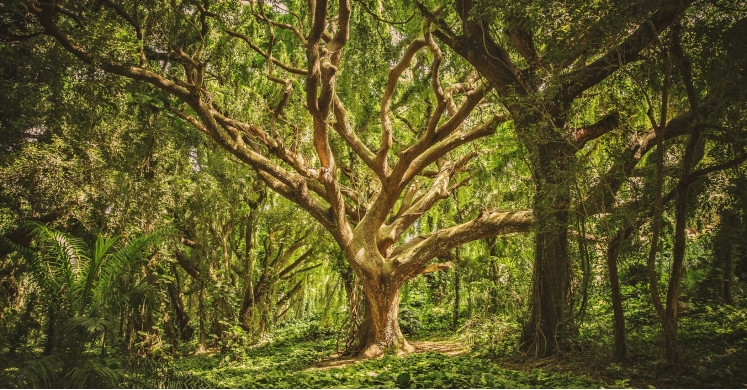Blog

#bioPGH Blog: Ancient Giants
 A resource of Biophilia: Pittsburgh, #bioPGH is a weekly blog and social media series that aims to encourage both children and adults to reconnect with nature and enjoy what each of our distinctive seasons has to offer.
A resource of Biophilia: Pittsburgh, #bioPGH is a weekly blog and social media series that aims to encourage both children and adults to reconnect with nature and enjoy what each of our distinctive seasons has to offer.
If we take a moment to close our eyes and dream back to childhood, how many years are we traveling through? A few years, a few decades? Longer? Some of us have several decades of wisdom accumulated, but there is a particular group of living things that exceed us all in age: trees, the ancient giants living among us. Three different Bristlecone pines in the US each lived for approximately five thousand years, and two of the oldest known Sequoia trees lived well over three thousand years. Trees’ longevity and sky-reaching heights have captured imaginations for millennia, and they have intriguing ecological trivia as well. Let’s explore!
Most of us need little reminder that past and present generations have all been fascinated by trees, and most cultures have included arboreal references in their symbolism, legends, and stories. Here in Pennsylvania, we can point to the Sacred Oak in Berks County, an immense 500-700 year old tree at the center of a Lenni-Lenape account of miraculous healing. On a more cosmic scale, ancient Norse mythology believed that the nine worlds of the universe were held in the branches of giant ash tree called Yggdrasill. However, trees have left their literary mark beyond historical indigenous tradition. As a modern illustration of this, let’s turn to a popular book series featuring a bespectacled young wizard with a lightning bolt scar. Throughout the series, the wood of each characters’ wands were selected for both mythology and the biology surrounding the wood’s tree. For example, the main villain’s wand is made of yew, a conifer whose foliage and berry seeds are toxic to humans, while the protagonist-who-lived has a wand made of holly, which symbolizes evergreen life.
Aside from the folklore and mythology, here in Pennsylvania our native landscape was dominated by trees; our state name literally translates to “Penn’s Woods!” Broad-leaved, deciduous trees make up the majority of forests in the state, and most of our forests are a blend of red and white oaks, hickories, maples, beeches, tulip poplar, birches, pines, basswood, and (our state tree) Eastern hemlocks. All of our state is considered a part of North America’s eastern temperate forest ecoregion—meaning the state largely follows similar patterns of climate, geology, topography, vegetation, and hydrology. Different land use across the state, though, has resulted pockets of old-growth forests (old, mature stands of trees) amid new growth in parks or on reclaimed lands. The presence or absence of forest trees defines the majority of terrestrial wildlife habitat in the state, and trees are a backbone of their wild communities.
What is most intriguing about trees is that they aren’t just pretty scenery for humans; they actually are quite beneficial—even outside of their role in ecosystem services. We humans seem to have an innate connection to nature (biophilia), and somehow…nature grounds us. Far from fluffy pseudoscience, though, the top corporate workspaces around the globe have noticed significant boosts in employee productivity and creativity when staff have regular access to green spaces, and taking even short breaks around trees decreases blood cortisol levels—indicating a reduction in stress. There is also quantifiable data indicating that the presence of green spaces (such as gardens) at hospitals can lead to faster recovery times and less needed pain medication for patients; and within schools, students with access to green space outcompete their peers—even when results are adjusted for socio-economic variables. Add all of this to the results of a recent study of over 5000 companies indicating that green employer practices lead to significant increases in employee productivity, and it becomes clear that what is good for the environment and what is good for trees is also good for human health and our economy.
So let’s hear it for trees!
Connecting the Outdoors Tip: Since we are lucky Pennsylvania is home to so many state forests, be sure to check them out! And if you are a super tree supporter, you might want to check out the Allegheny National Forest Plant-A-Tree Program. For a small donation, you can help support the next generation of the forest and help ensure its beauty for decades to come!
Continue the Conversation: Share your nature discoveries with our community by posting to Twitter and Instagram with hashtag #bioPGH, and R.S.V.P. to attend our next Biophilia: Pittsburgh meeting.
Resources
PA DCNR: An Auto Tour of Old-Growth Forests
PA DCNR: Common Trees of Pennsylvania
Encyclopedia Britannica—Yggdrasill
National Park Service: Eastern Deciduous Forest Ecosystem
Environmental Protection Agency: Ecoregions
MN DCNR: What is an Old Growth Forest?
Harvard Business Review: Why You Should Tell Your Team to Take a Break and Go Outside
Scientific American—How Hospital Gardens Help Patients Heal
CBS: Top Five Oldest Trees in the US
Photo Credits: Pexel CC0 images

